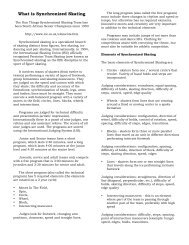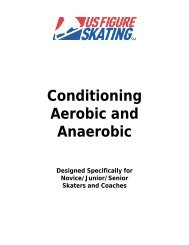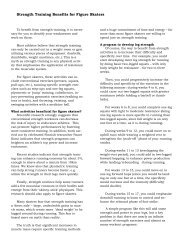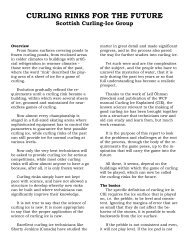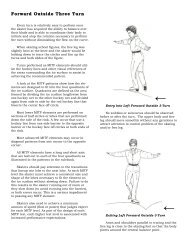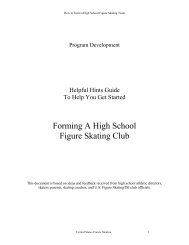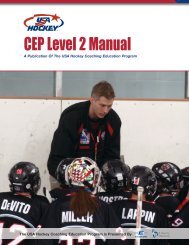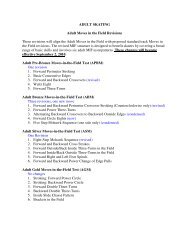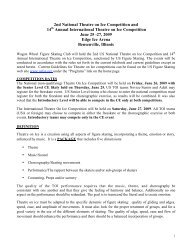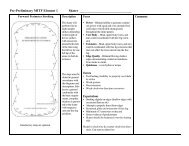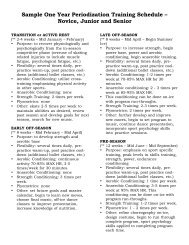CEP Level 3 Manual - Rushmore Hockey Association
CEP Level 3 Manual - Rushmore Hockey Association
CEP Level 3 Manual - Rushmore Hockey Association
Create successful ePaper yourself
Turn your PDF publications into a flip-book with our unique Google optimized e-Paper software.
T A B L E O F C O N T E N T STo successfully check an opponent along theboards, the checker must angle the puck carrier intothe boards under controlled speed. He/She givesthe puck carrier only one option, not two (SeeFigure 8). He/She forces the puck carrier in thedirection he/she wants him/her to go, squeezing theopponent on the boards using his/her arms andbody. Push, with your inside arm, down and acrossyour opponents chest then move your body in frontof the attacker, blocking his path (See Figure 9).After contact be sure to keep your body low andwell-balanced (See Figure 10).Figure 4. Completing the Hip Check.Figure 6.Key ElementsExecuting the “Hip Check alongthe boards”.If the puck should become tangled in skatesalong the boards, you may want to freeze it to gainpossession. This often allows your team toreorganize.Figure 9.The checker must move his/herbody in front of the puck carrier.• Watch the puck carrier’s chest, not the puck• Knees bent• Head and shoulders lowered• Thrust the hip into the stomach area of theoffensive playerCommon ErrorsFigure 5.Angling the puck carrier towardsthe boards.• Looking at the puck instead of watching thepuck carrier’s body• Knees are not flexed when initiating thecheck• Poor timing (this often allows the attacker toskate by as if there was no defense)CHECKING ALONG THE BOARDSThe ability to check properly along the boardswill enable a team to regain possession of the puckwithout receiving a penalty. The defender mustconcentrate on the puck carrier, not the puck, usingtiming to angle the attacker towards the boards. Ashe/she approaches the puck carrier from an angle,the checker reduces the amount of space betweenhimself/herself, the puck carrier and the boards.The checker must have two hands on the stick withthe blade on or near the ice (See Figure 7).(Coaches must emphasize that the stick must bekept down). The checker should aim to hit a pointon the boards in front of the puck carrier. Typically,the defender should not attempt to retrieve the puckhimself/herself, as this is usually done by ateammate.Figure 7.Figure 8.The checker must approach the puckcarrier with two hands on the stick.Angling the puck carrier tothe boards.Figure 10. Maintain good body balance incompleting the check.Key Elements• Angling your opponent• Controlled speed at the point of contact• Use inside arm to pinch your opponent intothe boards• Keep your body low, legs spread for balanceCommon Errors• Approaching the puck carrier straight on, notangling• Banging your opponent rather than pinchinghim into the boards• Failing to maintain good body balance266 | USA <strong>Hockey</strong> Coaching Education Program <strong>Level</strong> 3 <strong>Manual</strong>Defensive Team Tactics | 267



